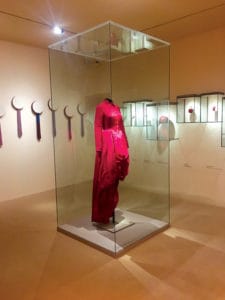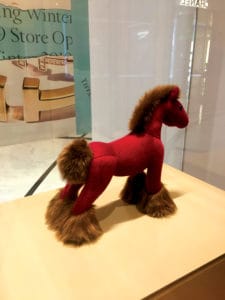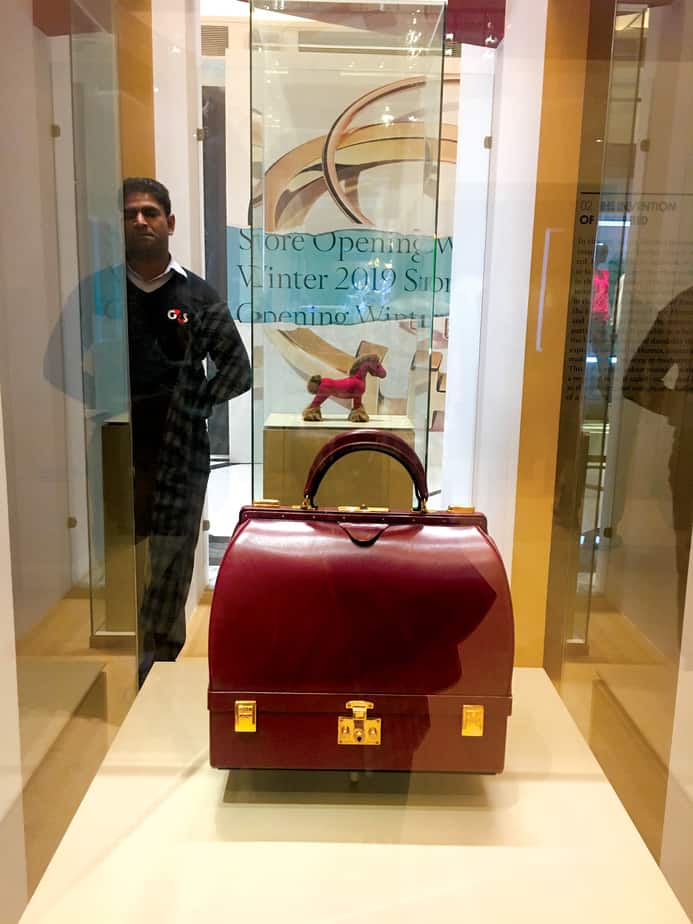French luxury brand Hermès may be way out of reach of anybody but the super-rich but it uses many Indian artisans, and its exhibition in Delhi is itself a work of art
Greek mythology says that Hermes is the god of trade, roads, travellers, athletes, trickery and all things sporty. Now to identify a luxury bag with that name in the contemporary world may sound outlandish but there are parallels one can draw.
Remember ‘Bagwati’ from Zindagi Na Milegi Dobara? – a character in its own right was from the French high fashion luxury goods manufacturer Hermès (pronounced air-mez) known for its high-quality leather products. The brand’s logo of a Duc carriage with horse rightly describes the history of the brand, that started making high-quality harnesses and saddlery in 1837 for the elites of the time. The retention of the logo design with its current multifarious product range tells you something about the brand, currently showcasing a selection of its archives at The Chanakya, New Delhi as part of a travelling exhibition – until December 8.

Émile-Maurice, a third-generation successor of the label is known to introduce the Hermès philosophy during his leadership as “Leather, sport, and a tradition of refined elegance”. The exhibition sprawled across five chambers on the ground floor of the upscale Delhi property puts forward the artisanship and legacy curated by Bruno Gaudichon of La Piscine museum of art and industry in Roubaix, France and envisioned by Ménéhould de Bazelaire du Chatelle, Artistic Director of the Cultural Patrimony of Hermès.
Centrally located, close to the Hermès store, space reeks of 183 years of heritage that the brand boasts of. The Rouges Hermès-Heritage Exhibition gives homage to 40 shades of red that it has used extensively in its signature bags, scarves, furnishings and perfumes.
As one enters the premises, a painting by an unknown artist features the company headquarters in Paris in its original state, a three-storey corner building at 24 Rue du Faubourg Saint-Honoré, part of which is painted in one of the reds that inspired the crimson legacy. The five rooms take us through the journey of how red has been incorporated by the brand in its iconic product range of leather saddle, scarfs, tableware, toys, bags, apparel and even a dressing table. Each object has its own story of how it got introduced into the brand lineage.
Hermès, with its almost two-centuries-old history has had celebrities give their name to its bag on more than one occasion. In 1956, Life magazine featured a photograph of Grace Kelly carrying the “Sac à dépêches” bag where she was seen holding it in front of herself to hide her pregnancy. The media attention the bag received led to it being named as the ‘Kelly’ bag by the brand.
?In 1983, its then chief executive Jean-Louis Dumas was seated next to actress Jane Birkin on a flight where the contents of her straw travelling bag fell to the deck from the overhead compartment, leaving her to scramble to recover its contents. This led to Dumas creating a bag for her, which since then is known as the Birkin Bag, the most famous handbag ever. These bags are known as the symbol of wealth and exclusivity due to their high price and waiting lists of over six years.
In the first chamber is on display a handbook with extensive details laid out by Emile Hermès on the craftsmanship for the benefit of upcoming generations of artisans who would be working at the company.
A little ahead comes a corner that demonstrates the process used by the label’s tanneries, through which the brand got its iconic deep red colour and other shades. This is also when you will hear the soundtrack of a horse running and workers in a factory, creating a sense of places and ideas that were on exhibit.

The person representing Hermès at the exhibition adds that Emile Hermès had a deep-rooted connection with India as many of the craftsmen in his workshop were Indians.
Hermès’s continuation of the exclusive use of natural materials like skins of lamb, calf, alligator, etc., for its products, unlike other companies, in spite of it causing a decline in its business, is the discipline by which the brand has progressed in these years.
The leather bags on display show the evolution of their material, design and usage through years for both men and women and how the brand has used every opportunity to create a product their clientele would love. A leather bag used to serve food to horses was once redesigned as a woman’s bag. One of the bags, with its design close to a duffel bag, was made just to be put in window displays back in the day. Perhaps a mighty unusual shape in olden times but a regular one in today’s day and age.
The firm’s affinity to traditional business models and rejection of mass production and mechanisation has helped the brand retain its high-quality manufacturing at the scale it does. Its products are entirely hand-made in France in middle-sized workshops known as Les Ateliers Hermès.
The brand is going strength to strength among the elites around the world with annual revenue of $7 billion and assets of $5.3 billion. Forbes magazine puts it at 33rd position in its list of the most valuable brands around the world.
From being the object of an old person’s nostalgia, Hermès has gone on to become the subject of young people’s dreams. This has led to its current repertoire of 14 product divisions that encompass leather, scarves, ties, men’s and women’s wear, perfume, watches, stationery, footwear, gloves, enamelware, decorative arts, tableware, and jewellery.
The exhibition ends with a modular dressing table, with pockets and drawings made out of leather. A gift from Emile Hermès to women his time and this time.
Fun facts:
- Zippers were known as Hermès fasteners in France when they first made an appearance. Émile-Maurice was the first person to use it in France and was granted the exclusive rights to do so in 1918. His first leather golf jacket that was made for Edward, Prince of Wales, featured this zipper.
- Hermes collaborated with jewellery and shoe designer Pierre Hardy, to make a solid rose gold Kelly bag dotted with a total of 1,160 diamonds. The price tag of $2 million makes it the second most expensive bag in the world.
- Hermes artisans are given their very own personalised set of tools that they typically carry use till they retire.
- Hermes is one of the first luxurious brands which started an online trade.





